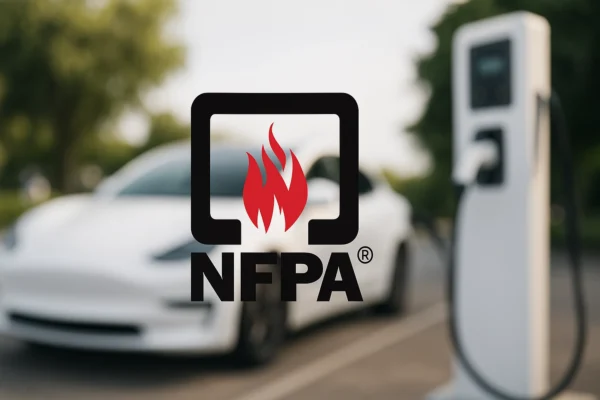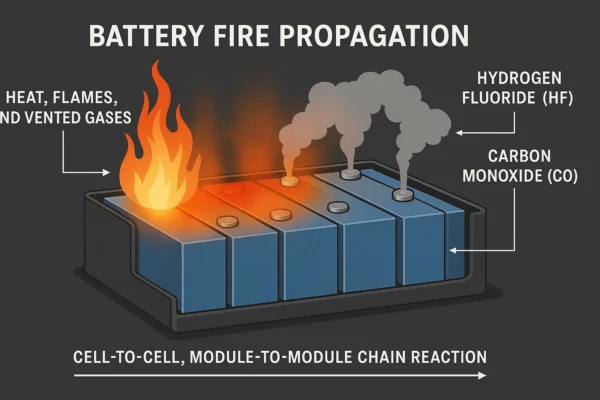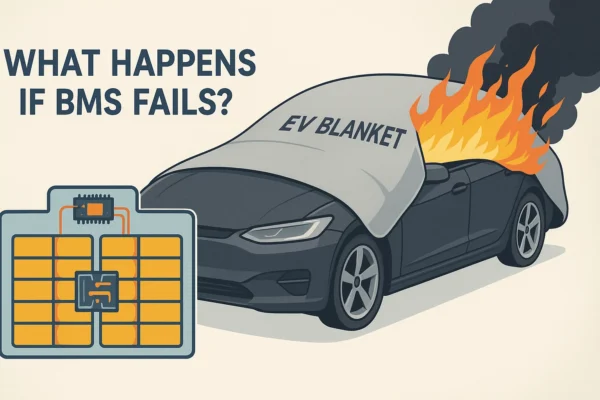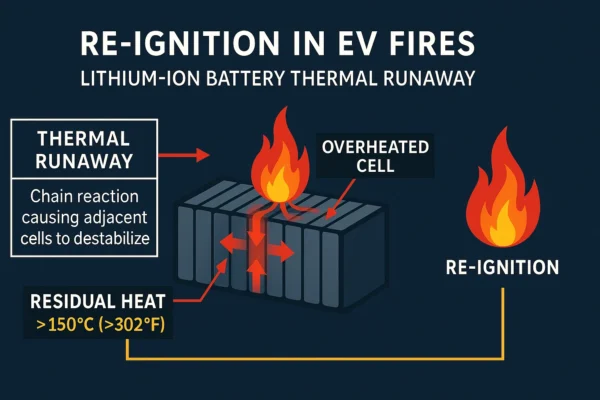Since 2020, electric vehicles (EVs) have become a dominant global trend. Their quieter operation compared to combustion engine vehicles, faster acceleration, lower operating costs, and superior human-machine interaction have all contributed to the widespread adoption of automotive electrification.
However, the rise of new technologies has brought new challenges. As thermal runaway in lithium-ion batteries becomes a more prominent issue, the number of EV fire incidents has increased significantly. Unlike fires in traditional combustion engine vehicles, which can often be addressed using standard fire extinguishers to mitigate the fire risk, electric vehicle fires pose unprecedented challenges. Lithium-ion battery fires often render conventional emergency response tools, such as fire extinguishers or fire blankets, insufficient. A single fire protection measure is rarely enough to fully extinguish an EV fire.

Since 2010, organizations such as the NFPA (National Fire Protection Association) and the USFA (United States Fire Administration) have issued EV fire safety guidelines and developed firefighter training programs to address the growing need for specialized knowledge in managing these incidents. At Safeprotex, we aim to build on these resources to help you better understand how firefighters put out electric car fires. Our goal is to ensure that, in the event of an EV fire, you can take the necessary steps to protect yourself and those around you, especially if emergency responders have not yet arrived.
Steps Firefighters Use to Put Out Electric Car Fires
As of 2024, the main steps for firefighters to put out electric car fires are:
- Risk Identification: Assess potential thermal runaway and other hazards.
- Establishing a Safety Zone: Secure a large perimeter to protect against explosions or toxic gases.
- Cooling Operations: Use extensive water to reduce battery temperature and stop thermal runaway.
- Continuous Monitoring: Monitor for re-ignition using thermal imaging and other tools.
Risk Identification in EV fire suppression
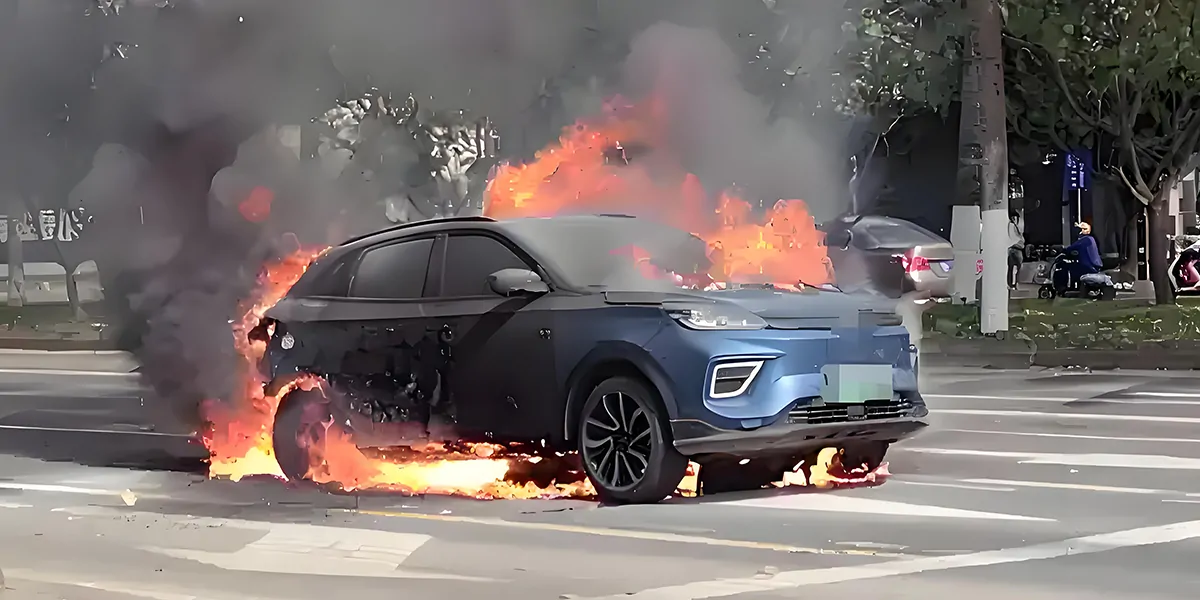
The first and most critical step in EV fire suppression is identifying key risks, which include toxic fumes, battery explosions, electric shock hazards, and the potential for re-ignition. Proper recognition and management of these risks are essential for ensuring safety and effective firefighting operations.
Toxic Fumes
Toxic fumes are one of the primary hazards associated with EV battery fires. During combustion, lithium-ion batteries release harmful gases such as hydrogen fluoride (HF) and carbon monoxide (CO), which pose serious threats to human health and the environment. These fumes not only reduce visibility, complicating firefighting efforts, but also create long-term environmental and health concerns.
Battery Explosions
Battery explosions represent another critical risk. Thermal runaway in lithium-ion batteries can lead to violent explosions, causing high-velocity projectiles and the ejection of high-temperature materials. These phenomena endanger nearby personnel and significantly compromise fire safety for the surrounding environment.
Electric Shock Hazards
The high-voltage systems in EVs, typically operating between 300 to 800 volts, increase the risk of electric shock, particularly when circuits are exposed or water is used as a suppression medium. This risk demands specialized precautions and tools during EV fire suppression.
Re-ignition Potential
The risk of re-ignition is another major challenge. Batteries that are not completely cooled may reignite hours or even days after the fire appears to be extinguished, exacerbating damages and complicating recovery efforts.
Mitigation Strategies
To address these electric vehicle fire safety risks, firefighters must:
- Wear self-contained breathing apparatus (SCBA) to avoid inhaling toxic fumes.
- Maintain a safe distance of at least 50 meters to protect against explosions and flying debris.
- Use insulated tools to minimize electric shock risk, and ensure the EV’s power system is disconnected before suppression efforts begin.
- Continuously cool the battery to prevent re-ignition and monitor its temperature with thermal imaging cameras to identify potential hot spots.
Effectively identifying and mitigating these risks is the foundation of EV fire suppression, ensuring both the safety of emergency responders and the efficient containment of the incident.
Ensuring Personnel Safety During Electric Vehicle Fire Suppression
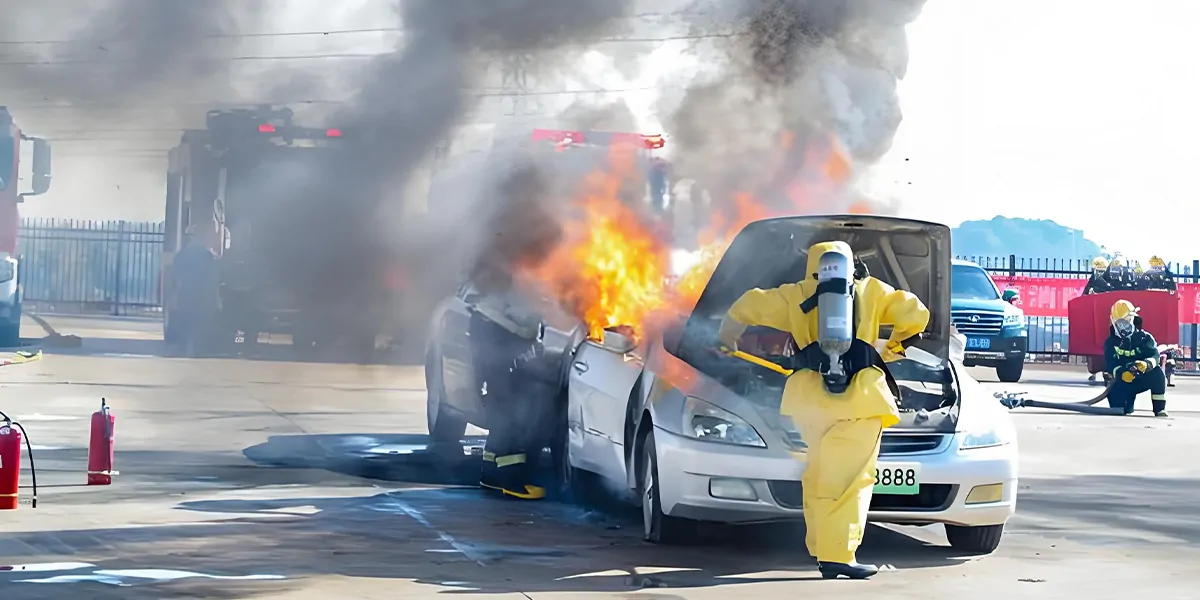
Scene Assessment
Before initiating suppression efforts, firefighters must thoroughly assess the fire scene to identify potential hazards, including high temperatures, toxic fumes, battery explosions, and electric shock risks.
- Toxic Fumes: EV fires release large amounts of hazardous gases, such as hydrogen fluoride (HF) and carbon monoxide (CO), which can cause asphyxiation or poisoning.
- Battery Explosions: Thermal runaway may result in violent explosions, with high-temperature gas and projectiles posing risks to nearby personnel and the environment.
- Electric Shock: High-voltage battery systems in EVs, especially when circuits are exposed or leaking electricity, increase the risk of electrocution.
To mitigate these risks, a safety perimeter of at least 50 meters should be established, ensuring non-essential personnel are evacuated and kept clear of the danger zone.
Power Disconnection
Disabling the vehicle’s power system is crucial to reducing electric shock risk. This involves using emergency disconnect devices or manually severing high-voltage cables to fully isolate the battery from the electrical system.
- Firefighters must wear fire-resistant clothing, insulated gloves, and insulated boots while performing this task.
- Insulated tools should be used to prevent accidental conductivity, and voltage detection equipment must confirm that no residual current remains before proceeding with suppression efforts.
Protective Measures During Suppression
To address the risks of explosion and re-ignition:
- Maintain a safe distance and prioritize the use of remote water application systems to cool battery modules effectively.
- Even after the visible flames are extinguished, the chemical reactions within the battery may lead to re-ignition. To counter this, apply continuous cooling with large volumes of water and monitor the battery temperature using thermal imaging cameras.
Once the fire is fully suppressed, the vehicle should be relocated to an isolated area, such as a water pool or an open field, to minimize the risk of secondary incidents.
Emergency and Post-Fire Procedures
Throughout the suppression process, firefighters must wear self-contained breathing apparatus (SCBA) to protect against toxic fumes. Additionally, an on-site emergency medical station should be established to treat potential injuries, including burns, electric shock, or inhalation poisoning.
Establishing Safety Zones for Electric Vehicle Fires

Creating a safety zone is essential to manage risks such as toxic fumes (e.g., hydrogen fluoride and carbon monoxide), thermal runaway-induced explosions, extreme heat, and secondary hazards like flying debris or electric shock.
The process begins with assessing fire behavior, vehicle type, and signs of thermal runaway, such as white smoke, sparks, or hissing sounds. A safety perimeter of at least 50 feet should be established, with extensions to 100 feet or more if explosion risks, like battery swelling or audible hissing, are evident. Boundaries must be clearly marked using traffic cones or barriers, and conditions should be continuously monitored with thermal imaging cameras and gas detectors, adjusting the safety zone as necessary.
Safety zones are critical in cases of active thermal runaway, prolonged suppression efforts, high-density locations, explosion risks, or fires near flammable materials.
Key equipment includes full firefighting PPE such as SCBA and thermal shields, traffic control tools like cones and tape, monitoring devices like gas detectors and thermal imaging cameras, and suppression tools such as water supplies, debris control blankets, and portable ventilators.
This structured approach ensures maximum safety for responders and the public while enhancing fire suppression effectiveness.
Cooling Techniques for Electric Vehicle Fires
Cooling is the foundation of effective firefighting for electric vehicle (EV) fires, particularly due to the challenges posed by lithium-ion batteries. When thermal runaway occurs—an uncontrollable process of overheating—it generates temperatures exceeding 1,000°F (538°C), accompanied by explosions and toxic gas emissions like hydrogen fluoride (HF). Proper cooling not only halts thermal runaway from spreading between cells but also suppresses flames and reduces the risk of reignition. Research demonstrates that extinguishing an EV fire often requires 2,600–3,000 gallons of water, far surpassing the 500–800 gallons needed for conventional vehicles. Sustained water application can reduce battery temperatures to below 300°F (150°C) within 20–40 minutes, but reignition remains a threat unless the battery is cooled to a stable temperature below 120°F (50°C).
Thermal imaging cameras are indispensable for identifying hotspots, typically within or beneath the battery pack, ensuring targeted and effective cooling. Continuous application of water is essential, as intermittent sprays fail to dissipate the extreme heat generated by thermal runaway. These techniques are especially critical in scenarios where flames threaten adjacent cells, flammable materials, or densely populated areas, as well as during prolonged suppression efforts or when signs of battery instability, like hissing or swelling, are evident.
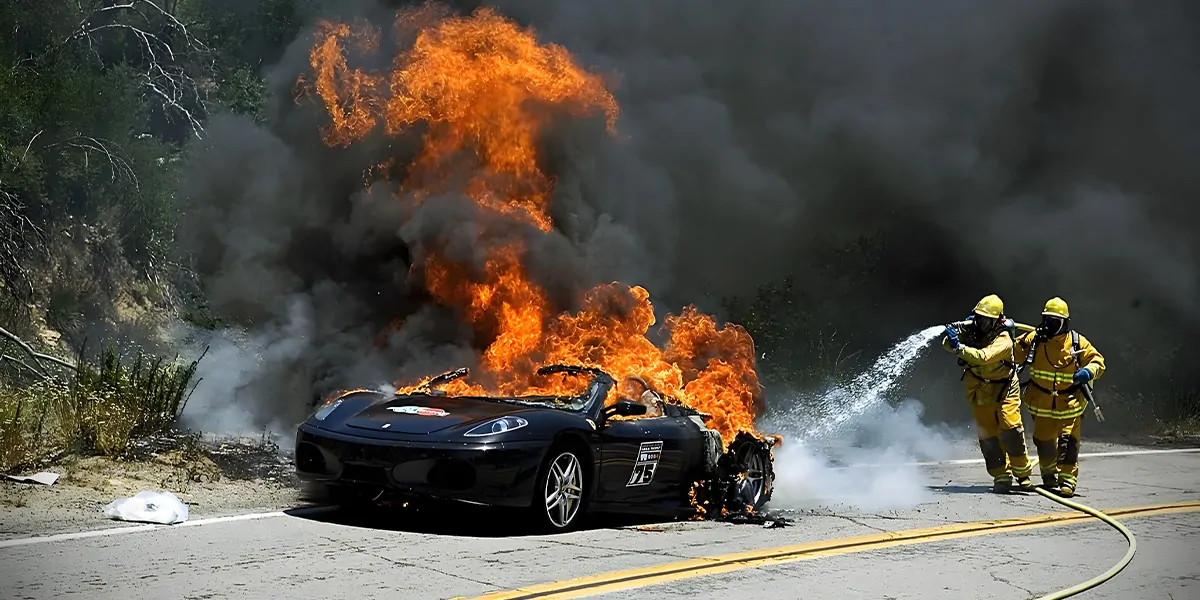
Effective Cooling Techniques
- Identify Heat Sources: Use thermal imaging cameras to locate hotspots within the battery pack.
- Apply Continuous Water Streams: Direct a steady water flow onto the battery housing to ensure consistent cooling and prevent heat propagation.
- Ensure Safe Positioning: Maintain a perimeter of at least 50–100 feet to protect responders from debris or explosions.
- Monitor Progress: Continuously track battery temperatures with thermal imaging to confirm cooling effectiveness and detect hidden hotspots.
While water remains the most practical and efficient cooling agent due to its widespread availability and high heat absorption capacity, other solutions may complement its use in specific situations. Immersion tanks can quickly stabilize a battery by submerging it in water, though logistical constraints often limit their application to smaller vehicles or individual modules. Specialized foams and extinguishing agents can suppress flames but lack the cooling capacity to stop thermal runaway. Similarly, dry chemicals and sand are useful for smothering fires but are insufficient for dissipating the heat necessary to prevent reignition.
The combination of extensive water use, precision application, and ongoing temperature monitoring is key to managing the unique challenges of EV fires. This approach ensures that risks are minimized, and fires are suppressed as efficiently and safely as possible.
Post-Incident Monitoring for Electric Vehicle Fires
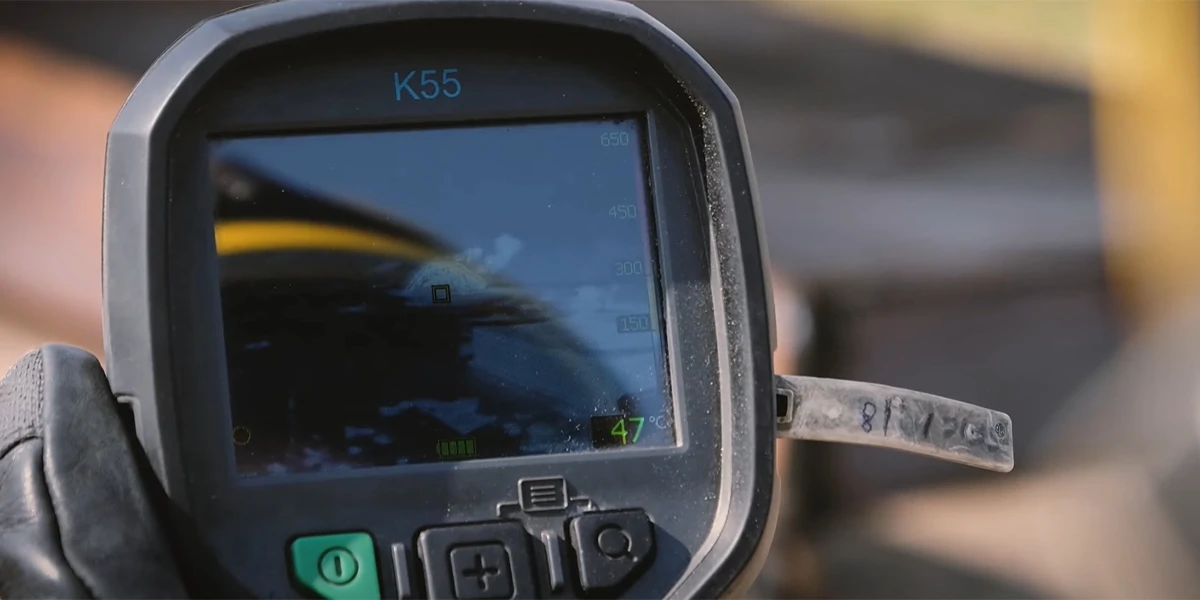
Post-incident monitoring is vital for managing the risks of EV fires, as lithium-ion batteries can reignite due to residual heat or delayed chemical reactions. Studies show up to 15% of damaged cells reignite within 24 hours, with temperatures exceeding 300°F (150°C) if not actively cooled. Proper monitoring involves relocating the vehicle or battery pack to a secure area at least 50 feet from flammable materials, continuous cooling to lower residual temperatures, and periodic inspections for 24–48 hours to detect anomalies or hotspots. Essential tools include thermal imaging cameras, temperature sensors, and fire suppression equipment, ensuring quick response to reignition risks. Advanced solutions such as immersion tanks, containment trailers, and automated monitoring systems provide additional safety for long-term observation.
Key Monitoring Practices
- Thermal Imaging: Use thermal imaging to locate hotspots exceeding 120°F (50°C).
- Extended Cooling: Apply sustained water cooling to stabilize battery temperatures.
- Isolation: Relocate the battery or vehicle to a safe, open area to prevent collateral damage.
- Visual Inspections: Monitor for smoke, swelling, or other anomalies that signal potential reignition.
- Long-Term Monitoring: Conduct regular temperature checks for up to 48 hours to ensure complete safety.
Combining continuous monitoring, advanced tools, and proactive measures significantly reduces the risks of reignition and ensures the safety of responders and the surrounding environment.
Are We Helpless Before Firefighters Arrive?
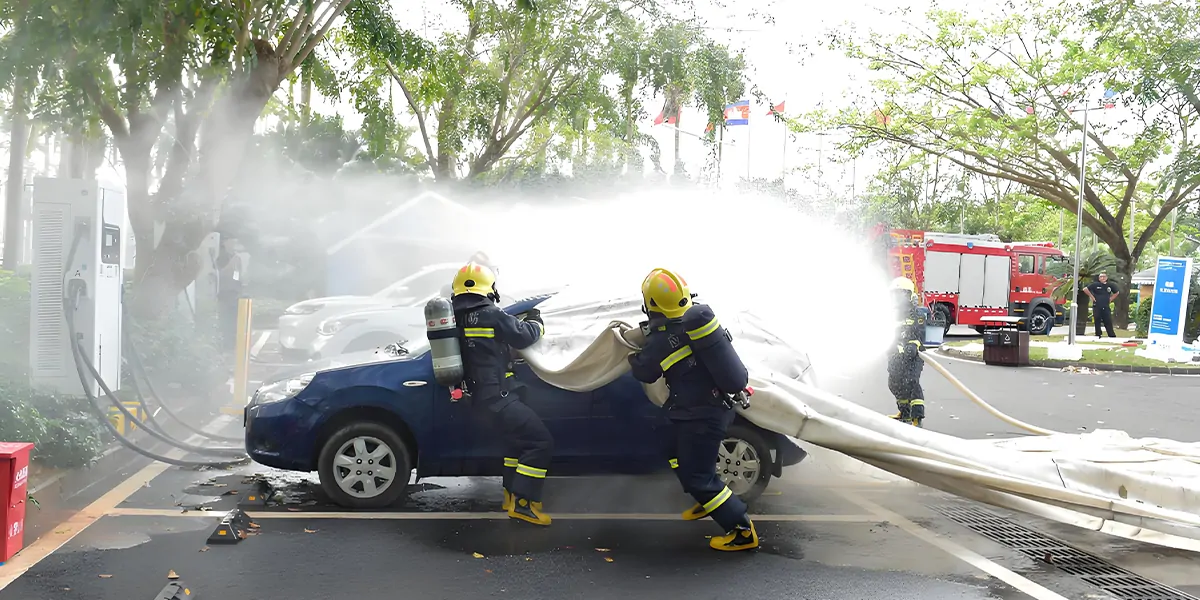
Not at all. Before firefighters arrive to manage the situation, you can take proactive steps to control an electric vehicle (EV) fire using tools available at hand. Recognizing the unique challenges of EV fires compared to traditional vehicle fires, Safeprotex has developed the EV Car Fire Blanket—a practical solution to mitigate fire and toxic smoke risks during the critical time before professional help arrives.
How Do You Put Out An Electric Car Fire?
Thermal runaway events in electric vehicles (EVs) pose severe hazards, including flame propagation, elevated temperatures, high voltage risks, and the emission of toxic gases such as hydrogen fluoride. Conventional onboard fire extinguishers are often ineffective in suppressing electric vehicle fires. If you are not equipped with a fire blanket specifically designed for EV fire suppression, SafeProtex strongly recommends prioritizing the establishment of a safety perimeter and evacuating nearby vehicles and flammable materials to mitigate the risk of secondary fires until the EV is completely burned out.
However, if you are equipped with a SafeProtex EV Fire Blanket, the following steps will help you effectively minimize the spread of the battery fire and contain toxic gas emissions before the fire department arrives.
Steps for Using the SafeProtex EV Fire Blanket
1. Ensure Personal Safety:
Quickly retrieve the EV fire blanket while maintaining a safe standoff distance from the burning vehicle.
If available, don personal protective equipment (PPE), including heat-resistant gloves and respiratory protection, to shield yourself from high heat and toxic fumes.
Pre-plan your escape route to ensure a safe retreat if the fire intensifies unexpectedly.
2. Deploy the EV Fire Blanket
Approach the vehicle from the windward side (upwind) to minimize exposure to smoke and toxic gases.
Fully deploy the EV fire blanket, ensuring it is unfolded and draped over the vehicle in a manner that completely encapsulates critical areas, including the engine compartment and the battery housing.
3. Seal and Contain the Fire
Lithium-ion battery fires generate intense heat and upward air currents that can displace the EV fire blanket, reducing its effectiveness.
Use the steel tensioning ropes provided by SafeProtex to secure the blanket. Wrap the rope around the vehicle and fasten it tightly with the locking mechanism to ensure the blanket remains in place, even during strong thermal updrafts.
Once the blanket is secured, retreat to a safe observation distance. Monitor the blanket for signs of flames breaching the cover or evidence of thermal hotspots.
4. Await Fire Department Assistance
If a nearby water source (such as a fire hydrant or hose) is accessible, use it to periodically cool the exterior of the EV fire blanket. This helps to prolong the thermal barrier’s effectiveness and reduces the likelihood of reignition.
When professional firefighters arrive, immediately inform them of the deployment of the EV fire blanket to assist in their suppression strategy.
Safeprotex EV Fire Blanket
- High Heat Resistance: Withstands temperatures up to 1300°C.
- Reusable: Effective for 6–7 uses under normal conditions.
- Versatile: Suitable for EVs, conventional vehicles, and even LEV (Light Electric Vehicles).
- Customizable: Available in any size to fit specific needs.
- Certified Safety: Tested to ISO EN 13501-1, achieving a Class A1 fire rating.
Precautions
- Do Not Prematurely Remove the Blanket
- Removing the blanket prematurely can reintroduce oxygen to the enclosed fire, potentially causing a flare-up or reignition of the flames.
- Avoid Direct Exposure to Heat Sources
- Temperatures in EV fires can exceed 1,000°F (538°C), posing severe risks of injury or burns to anyone in close proximity without adequate protection.
- Stay Vigilant Against Reignition Risks
- Even after the blanket has contained the flames, residual heat within the battery cells may persist, leading to delayed thermal runaway propagation and subsequent reignition.
With years of experience in EV fire management, Safeprotex has developed a range of solutions designed to keep you prepared for emergencies. Visit our store or consult our experts to explore how Safeprotex can help you be ready for the unexpected. When it comes to protecting against EV fires, preparation is everything.
References
National Fire Protection Association (NFPA)
- Electric Vehicle Safety Training Program: Provides fire safety training for electric vehicles.
- Emergency Response Guides for Electric Vehicles: Emergency response guides for managing fires in various electric vehicle models.
- Electric Vehicle Charging Safety at Home (2024): A guide for safe home charging of electric vehicles to reduce fire risks.
U.S. Fire Administration (USFA)
- Electric Vehicle Fire Safety: Covers the risks and response strategies for electric vehicle fires.
- Lithium-Ion Battery Risks and Response Strategies: Focuses on risks and response strategies for lithium-ion battery fires.
- NTSB and USFA Collaborative Guidance on EV Fires (2020): Updated emergency response guides for electric vehicle fires.

